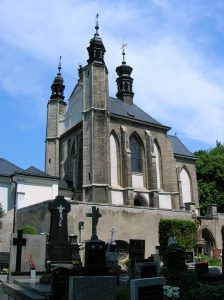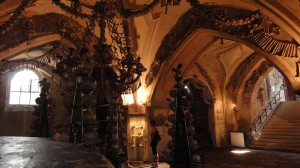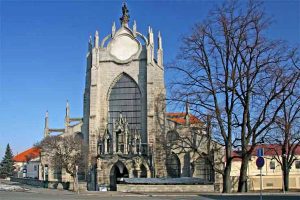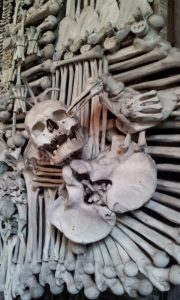The ossuary or Bone Church in Kutna Hora
By Tracy A. Burns
Located on the outskirts of Kutná Hora, the Sedlec ossuary in the All Saints Chapel features unique formations of more than 40,000 bones in a creepy and eerie atmosphere and is without a doubt one of the highlights of a visit to this town that is so rich in history, architecture, and art.
Hailing from the 12th century
 During the 12th century, the first Cistercian monastery in Bohemia was built on the grounds. In 1278 Bohemian King Přemysl Otakar II sent Henry, the abbot of Sedlec, to the Holy Land, and he came back with earth from Golgotha, which he sprinkled over the cemetery of the monastery. The Abbot hoped that by bringing this earth from Jerusalem many people would want to be buried there, and they did. Rich people throughout Central Europe desired to have their graves in Sedlec. The cemetery wound up being the final resting place for many plague victims and fallen soldiers. In 1348 alone 30,000 people who succumbed to the Black Death were interred there.
During the 12th century, the first Cistercian monastery in Bohemia was built on the grounds. In 1278 Bohemian King Přemysl Otakar II sent Henry, the abbot of Sedlec, to the Holy Land, and he came back with earth from Golgotha, which he sprinkled over the cemetery of the monastery. The Abbot hoped that by bringing this earth from Jerusalem many people would want to be buried there, and they did. Rich people throughout Central Europe desired to have their graves in Sedlec. The cemetery wound up being the final resting place for many plague victims and fallen soldiers. In 1348 alone 30,000 people who succumbed to the Black Death were interred there.
From the 15th century to the 17th century
 The All Saints Chapel above the ossuary dates from the 14th century before the Hussite Wars began. A chapel was constructed on the upper floor while the ossuary, the place where abandoned bones were gathered, was built below it. Ossuaries emerged because there was not enough space for all the deceased to be buried in individual coffins. To make room for the church, some graves were unearthed, and the skeletons were placed in the ossuary. During the Hussite wars, many soldiers were interred in the cemetery, although in 1421 the Hussites razed the monastery. Shortly after 1511, a half-blind monk piled bones from abolished graves into pyramids. The bones were rearranged in 1661.
The All Saints Chapel above the ossuary dates from the 14th century before the Hussite Wars began. A chapel was constructed on the upper floor while the ossuary, the place where abandoned bones were gathered, was built below it. Ossuaries emerged because there was not enough space for all the deceased to be buried in individual coffins. To make room for the church, some graves were unearthed, and the skeletons were placed in the ossuary. During the Hussite wars, many soldiers were interred in the cemetery, although in 1421 the Hussites razed the monastery. Shortly after 1511, a half-blind monk piled bones from abolished graves into pyramids. The bones were rearranged in 1661.
Santini’s Baroque-Gothic style
Well-renowned architect Jan Antonín Blažej Santini-Aichel renovated the ossuary in his stunning Baroque-Gothic style from 1703 to 1710. He is reputed for his unique and innovative style that is very geometric and uses hidden symbols. He often added details where there were none and omitted details where they were usually placed. In the ossuary, he made crowns above pyramids and formed candelabra from bones. When he was 26 years old, in 1703, he also redesigned the Sedlec Monastery Church of the Assumption of the Virgin Mary and Saint John the Baptist, near the ossuary.
Santini’s creations throughout the Czech lands
 Santini-Aichel made a name for himself not only in Sedlec but also throughout the Czech lands. His designs include the geometric Church of Saint John of Nepomuk on Zelená hora in Žďár nad Sázavou, the Kladruby and Plasy monasteries as well as chateaus in Chlumec nad Cidlinou, Rychnov nad Kněžnou and Bělohrad Lázně. His work can be seen throughout Prague as well. He was responsible for the construction of buildings in the Lesser Quarter plus many structures in Prague’s Hradčany district. He even worked on Saint Vitus’ Cathedral.
Santini-Aichel made a name for himself not only in Sedlec but also throughout the Czech lands. His designs include the geometric Church of Saint John of Nepomuk on Zelená hora in Žďár nad Sázavou, the Kladruby and Plasy monasteries as well as chateaus in Chlumec nad Cidlinou, Rychnov nad Kněžnou and Bělohrad Lázně. His work can be seen throughout Prague as well. He was responsible for the construction of buildings in the Lesser Quarter plus many structures in Prague’s Hradčany district. He even worked on Saint Vitus’ Cathedral.
The Schwarzenbergs enter the picture
In 1784, shortly after Holy Roman Emperor Josef II abolished the monastery, the Schwarzenbergs bought the ossuary and surrounding area. The bones and skulls were arranged into various shapes. The current appearance of the bones hails from 1870, courtesy of woodcarver František Rint.
Bone formations in the ossuary
 The bones decorate the ossuary in astounding, ghoulish shapes. Macabre skulls gaze intently at visitors. Baroque candelabra form a Gothic tower. Some bones are shaped as chalices while others appear in the form of two enormous monstrances flanking the main altar. Bones are arranged as the Schwarzenberg coat-of-arms portraying a severed Turk’s head and a raven. (In 1598 Prince Adolf of Schwarzenberg conquered the Hungarian settlement of Raab, a triumph that seriously weakened the Turks. In recognition of this achievement, Holy Roman Emperor Rudolf II placed a severed head of a Turk on the Schwarzenberg coat-of-arms.) Also, a huge chandelier boasts all the bones of the human body. Bones shaped as bells stand in the four corners of the chapel. Skulls from soldiers during the Hussite wars of the 1420s are also on display in the chilling space.
The bones decorate the ossuary in astounding, ghoulish shapes. Macabre skulls gaze intently at visitors. Baroque candelabra form a Gothic tower. Some bones are shaped as chalices while others appear in the form of two enormous monstrances flanking the main altar. Bones are arranged as the Schwarzenberg coat-of-arms portraying a severed Turk’s head and a raven. (In 1598 Prince Adolf of Schwarzenberg conquered the Hungarian settlement of Raab, a triumph that seriously weakened the Turks. In recognition of this achievement, Holy Roman Emperor Rudolf II placed a severed head of a Turk on the Schwarzenberg coat-of-arms.) Also, a huge chandelier boasts all the bones of the human body. Bones shaped as bells stand in the four corners of the chapel. Skulls from soldiers during the Hussite wars of the 1420s are also on display in the chilling space.
Other ossuaries in the Czech Republic and in Europe
In Brno, the capital of Moravia, an ossuary with the bones of 50,000 people, is located under Saint James Church. Only recently opened to the public, this bone church is the second biggest in Europe. Other ossuaries appear throughout Europe: the Santa Maria Della Concezione in Rome, Italy; the Capela dos Ossos in Evora, Portugal; the Chapel of Skulls in Czermna, Poland; the Paris catacombs; and the Skull Tower of Niš in Serbia.




